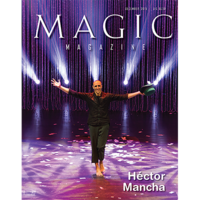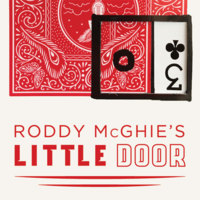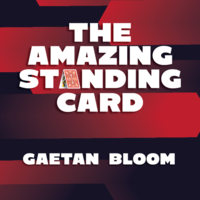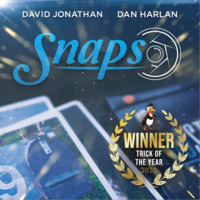Magic Magazine December 2015
| List price: | |
| Price: | $4.80 |
| You save: | $1.35 (21%) |
CONTENTS
DECEMBER 2015
VOLUME 25
NUMBER 4
Héctor Mancha - This Year, The Work Paid Off
By Jaq Greenspon
He's a Spanish close-up magician who does a pickpocket act. So how did Héctor Mancha win the top prize in Manipulation and the Grand Prix at FISM this year? By inventing new techniques for working with cards and bills.
Doug Henning's World of Magic
By Tod Gerard
Doug Henning had become a star on Broadway, but relatively few people had seen him work. That all changed - as did the future of stage conjuring - on December 26, 1975, when The World of Magic was broadcast live to millions of people across the US.
Better Magic Through Chemistry
By Jaq Greenspon
"What could be interesting in bubbles?" That's what Marco Zoppi wondered, but the magician from Italy combined conjuring and his college chemistry studies to create a bubble act that is getting standing ovations.
Lynn Miner's Santa Magic
By Alan Howard
After working as a semipro magician during a long academic career, Lynn Miner reversed roles, turning to magic full time. For his stage persona, he adapted a character he already resembled - Santa Claus - and now he performs with that theme year round.
Plus Updates on...
- The Los Angeles Conference on Magic History.
- Casey Wong's larger-than-life statue of Houdini.
- Encore! Anthony Reed's new show in Guam.
- The 2015 MINDvention.
- The Magic & Meaning Conference's tenth anniversary.
- Rafael celebrates thirty years onstage.
- The ninth Shanghai International Magic Festival & Competition.
- "Comings & Goings" notes on the Hollywood Christmas Parade, an exhibit celebrating Jewish magicians, a Houdini séance, magic at sea, a Bullet Catch documentary, and an animated David Copperfield.
- A 33-minute interview with Doug Henning talking about his first TV special, conducted on video by David Charvet.
- All eighteen of the products reviewed in the December issue, plus 522 reviews from previous issues, are all now available at the fully searchable "Marketplace" section of M360.
Master Course: Cups and Balls Vol. 1 and 2 by Daryl
Distance by SansMinds Creative Lab
Joker Trick (Along for the Ride) by Peter Nardi
Sharpie BUG Writer by Vernet
Zero Set by Limin
Inspirations: Performing Magic with Excellence by Lawrence Hass
Hole 2.0 by Mickael Chatelain
Phantom by Peter Eggink
The Oriental Magic of the Bambergs by Robert Albo
Ultimatum Deck by Steve Brownley
Thick Card Project by Liam Montier
The Magic of Math by Arthur Benjamin
Flutter by Rizki Nanda
A Thought Well Stolen by Ben Harris
Impale by Jason Yu and Nicholas Lawrence
Name Tag by Agus Tjiu
Senti-Mentalism by Luca Volpe
Three Way Force Bag by Eran Blizovsky
- plus, our reviewers each pick one item they found especially impressive this year.
First Look: Implausibilities
Hudson Taylor
Hudson Taylor is a close-up magician from New York City, specializing in mathematical principles in card magic. Introduced to magic by his grandfather, Hudson developed a love of magic and math, which allowed him to create impossible effects and seemingly moveless magic. While there are many beautiful Any Card at Any Number routines, Implausiblities solves the method problem that most versions have - that the name of the card and its intended position in the deck must be known by the magician. Such conditions are unnecessary in Implausiblities. The Dropshift move is excerpted and adapted from Taylor's forthcoming Implausibilities DVD.
Loving Mentalism: Additional Thoughts
Ian Rowland
This month's article is all about how to read someone's mind without using any of the usual methods: no glimpses, impressions, or preshow; nothing written down, no force as we usually use that term, and no need to write anything in after the facts are known. An unusual aspect of the method is that you can tweak it to suit yourself: you can either have a 100-percent certain, surefire outcome, or you can adjust things slightly and leave yourself in the position where you know roughly what the spectator is thinking, but you need a bit of intuition and intelligent guesswork - in other words, real mindreading - to conclude the routine!
Bent on Deception: Santa's Wild Ride!
Mike Bent
For the family entertainer, this time of year means Christmas and holiday shows. These can be fun and profitable, but they can also be chaotic, and an almost a perfect show can be ruined by the big guy himself - Santa, who is rarely on time. Sometimes, he's early, but usually Mr. Claus is late. Rather than introducing him, then stand there feeling like an idiot for what seems like an eternity, I came up with a quick filler piece that fits the moment and can stretch or shrink to fit the situation. I call it Santa's GPS. Based on Val Evans' Optegramma effect, later popularized by Milbourne Christopher's road sign presentation, it's a simple, fun routine that I can grab and do in an instant if the situation presents itself. It takes up no space in my case and yet it plays very big.
The Monk's Way: Toys to Tools
Steve Reynolds
There are a lot of toys being hocked all around - moves, sleights, and flourishes of interest (for a month or so), until the next toys are sent up with the rest of the hoopla. But toys are not tools. Tools are designed to be integrated and used within working repertoires, within actual tricks performed when the going gets tough. I'm sharing two possible tools with you this month. The full details of how they function within a particular trick will be provided in next month's installment of "The Monk's Way," when you'll get the full scoop on Wilder Pocket Interchange. Until then, consider the next two items fun toys to play around with. That is, until they evolve in your hands into the tools they were designed to be.
Classic Correspondence: Dick Ritson to Edwin Dearn
Mike Caveney
Edwin A. Dearn was born on October 27, 1892, in Birmingham, England. At age fifteen he took up magic, but a year later he had given up the dark arts to become a ventriloquist. At 22 he moved to China, where his interest in magic was rekindled. Besides performing in and around Shanghai, Dearn also started collecting magic books and related ephemera. Dick Ritson, the author of this letter, was born on September 1, 1896, in Sheffield, England. After witnessing a performance by Chung Ling Soo, Ritson developed his own "Asian" magic act, appearing as Wu Ling the Magical Mandarin. When Okito toured Britain's provincial theaters, he and Ritson became friends, and Dick was fortunate to acquire one of Okito's original floating balls. Ritson eventually developed into a serious collector of magic memorabilia and, after reading reports of Edwin Dearn's fabulous collection in Shanghai, China, he sought to develop a friendship with him through the post.
For What It's Worth: When the Party's Over
Mark Kornhauser
A magician friend called me the other day and wanted to talk about some new material he was developing. Based on his description, it was difficult for me to be encouraging. He went on to explain that he didn't feel comfortable with the new piece but thought maybe it was simply the natural fear of breaking in something new. And then he explained that, after many years in the business, he had developed a keen intuition about what was good for him and what was not. He then decided not to do the piece. The psychological pressure of breaking in a new piece is, for many, genuinely debilitating. So I can't imagine a better 2016 New Year's Resolution than this: I will create at least one new original piece of magic and take it to performance level.
Walkabout Soup: The Institute of Layman Studies Part 2: The Blind Narration
Simon Coronel
After using last month's column to introduce The Institute of Layman Studies - ILS, my half-serious/half-facetious term for designing magic based on actual detailed feedback from laypeople - I thought it might be worth going into more detail about a specific ILS technique I now call "The Blind Narration." It works best with visual routines that you can perform slowly with minimal dialogue. When it works, it can provide a good approximation of real-time mindreading of what's happening in someone's head as they watch your routine. It works like this. Pick a layperson to be your subject. Ask another person to be "the listener." Ask the listener to turn their back so that they can't watch what you're doing. Explain to the subject that you're going to perform something, and they are to describe what's happening so that the listener can follow along.
ASK HERE



































